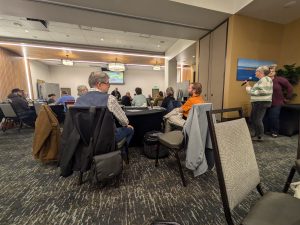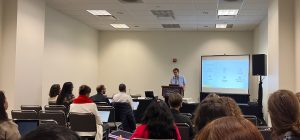Beyond Prediction: Building Capacity and Innovation in Adaptation Through a Participatory Evaluation
As the impacts of climate change intensify, communities across Washington are increasingly engaging in climate change adaptation planning to prepare for more frequent and severe climate impacts. Monitoring and evaluation of these plans is a crucial step to improve their efficacy and implementation, but often goes undone, as many communities struggle to assemble the resources and staff capacity evaluation requires. This leaves a critical blind spot as to whether a community’s adaptation practices are yielding the desired results. On a broader scale, adaptation evaluation is essential for learning from and improving adaptation. Evaluations inform us of what adaptation actions are being pursued, which are ever implemented, as well as if adaptation processes and plans are pursued equitably.
The North Olympic Development Council (NODC) is a regional economic council covering Jefferson and Clallam counties on Washington’s Olympic Peninsula. The NODC and its member communities are innovative leaders in adaptation planning, having facilitated several projects to develop resilience across the region. Since 2011, the NODC and its members have been engaged in an iterative regional adaptation planning dialogue, which included developing two regional adaptation plans in 2015 and 2022. Gus Wettstein, an MS student in the School of Environmental and Forest Sciences (SEFS) researching climate adaptation planning processes, partnered with the NODC to develop an evaluation of the NODC’s adaptation planning initiatives. This partnership was supported by the PCC’s Climate Solutions Fund, allowing Gus and the NODC to realize a more fruitful and sustained collaboration. For Gus, digging into the NODC’s adaptation efforts provided a unique opportunity to observe how the theories that organize the adaptation studies field operate on the ground within an innovative collaborative planning initiative. For the NODC, this evaluation provides insight into what participants thought worked well and what concerns regarding climate change impacts in the region may warrant further action.

As part of this evaluation project, Gus conducted a series of interviews with planning participants focused on their reflections on the planning process. The generous support of the PCC enabled Gus to think about engagement opportunities beyond holding interviews, and he sought ways to develop his evaluation into a more collaborative process. For example, in November of 2024 Gus hosted a focus group with the Clallam County WSU Extension office to discuss some of his early findings and the Extension staff’s experiences doing adaptation related work in the region. The focus group touched on the difficulties of translating the ambition of a plan into material action and change, particularly for capacity-constrained municipalities. This sentiment mirrors a broader finding of the evaluation. Funding, staff capacity, and technical expertise were all frequently cited as barriers to adaptation action in the region. Participants stressed that these issues, rather than a lack of scientific knowledge or motivation, are what stalls a plan’s implementation.
“I mean, they’re often… figuratively and, occasionally, literally putting out small fires at the transfer station. And so, getting it together for like long-term future, more abstract, planning is so far out of what I think they feel like they can manage” (Focus Group Participant, 11/5/24).
Findings like these can help the NODC target its efforts to foster adaptation action in the region by supporting member communities in capacity building that targets key adaptation barriers. This finding also points to how institutions like UW should maintain flexible and evolving means of engaging and aiding communities in adaptation, particularly as communities look beyond initial assessments to project implementation.

The Climate Solutions Fund also supported sharing the results of the evaluation project more widely. In March of 2025, Gus traveled to the 2025 American Association of Geographers (AAG) Conference in Detroit. Gus shared his preliminary findings in a session devoted to adaptation knowledge systems and innovation in adaptation scholarship. Both the AAG session and opportunities to share the evaluation work in the North Olympic Region enhanced the reach of this project. However, the full benefits of this partnership may take longer to emerge.
Adaptation does not call for one set of actions, as different climate hazards demand different solutions. The purpose of adaptation, too, is up for interpretation, with some seeing it as a means of protecting current valued practices and places, and others seeing it as an opportunity to transition and transform a community into a more resilient state. These broader questions of what adaptation should resemble and what it should value also arose through this project. As the NODC continues its mission of facilitating and promoting regional adaptation, opening questions of what adaptation could create, in addition to what it could preserve, are a central lesson from this project for both Gus and the NODC.
“How do we frame adaptation or community resilience in like, we’re making investments in the way we want our communities to be. And less in like we’re preparing for extreme sea levels and droughts and, like, how do we make that pivot. So, it’s less hazard risk reduction and more like we want our communities to be like this” (Interview # 25, 11/8/24).
This finding should extend to academic collaborators across the adaptation field as well, pushing them to see the assumptions certain models, interventions, and means of collaboration assume, and the potential futures these assumptions delimit.
By August Wettstein, PCC Climate Solutions Awardee, M.S. Student, University of Washington, School of Environmental and Forest Sciences